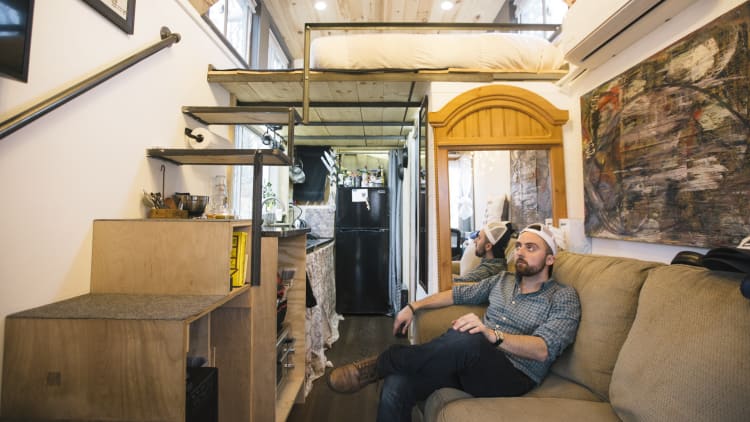
Is a "tiny home" for you?
For Nick Koridis it was. The 28-year-old wanted to own a home in the pricey suburbs of Long Island yet "didn't want to be like everyone else, struggling to make ends meet and pay off a mortgage."
So he paid cash for a tiny home shell from a builder for $28,000, plus about $6,000 in repairs and upgrades for a 200-square-foot residence he keeps in a friend's backyard, complete with power and water hookups. He pays $250 a month to lease the land and utilities and now has the flexibility to explore new career opportunities.
TV shows like "Tiny House, Big Living," "Tiny House Nation" and "Tiny House Hunters" have glamorized the small-home lifestyle and helped gain appeal among those looking to live with less.
Yet the reality for many is that in cities where a tiny home may work best — high density, amenity-rich areas — it may not be economical because high land costs limit resale potential.
"In the Washington, D.C., market it is hard to justify the land costs and the construction costs on tiny houses. A tiny house has such a limited market," said Sue Goodhart, real estate agent, The Goodhart Group at McEnearney Associates in Alexandria, Virginia.
"If the goal is to save money, I would have to say tiny home investors would need to go to areas where land prices are low, which means not located near major commuter routes."
It may also require a cash purchase, as lenders may be hesitant to lend on a structure that small, especially if it is on wheels, said Mike Arman, a retired Florida mortgage broker and real estate agent.
And there are other considerations.
Building permit and zoning regulations may prohibit homes of certain sizes or on wheels, Arman said.
"Your utility installation fees will be exactly the same as for a larger house, so will your cable and internet fees. About the only thing that will be cheaper is your power bill. … Your property taxes may be slightly less as well."
Best as an accessory?
That means tiny homes may work best either as permanent structures in RV resorts or as accessory buildings to larger homesteads, where owners of tiny houses may lease from landowners, said Kim Skobba, an assistant professor who teaches a course on tiny home construction at the University of Georgia.
For example, tiny home dwellers can purchase deeded RV lots for $20,000 to $30,000 on Lake Guinevere at Washington state's Skookum Resort, which offer amenities like a lodge with kitchen facilities, Wi-Fi, laundry facilities, an indoor pool and private boat launch. Large lot rentals at Lake Pleasant Mobile Home and RV Park in Beaver, Washington, can be rented for about $235 per month.
Demand is rising for smaller, more manageable spaces.
Homes less than 500 square feet are appreciating twice as fast as the overall market, according to realtor.com, which tracks nationwide sales of condos and single family homes. In December, the median list price of tiny homes was $119,000, up 19 percent from last year. The overall market median list price is up just 9 percent.
If the goal is to save money, I would have to say tiny home investors would need to go to areas where land prices are low.Sue GoodhartThe Goodhart Group at McEnearney Associates
Janet Thome helps sell tiny homes on her website TinyPortableCedarCabins.com, and assists small house owners find places to set up their homesteads legally and cheaply. The homes range in style and size (144 to 400 square feet), and can be sold as duplexes and triplexs, as well as custom built-to-order. They cost about $29,000 to $45,000 each.
Realtor.com also reports that residences under 500 square feet are twice as expensive as other homes nationwide, with the median list price per square foot reaching $281 versus $126 for all other homes. The hotter the area, the more expensive the tiny home.
This tiny home in Bethesda, Maryland, is priced at a whopping $459,000, or $1,500 a square foot — well above the going rate in one of D.C.'s most established suburbs.
While much of the cost is attributed to location, tiny homes can also be more expensive to build.
"There's a certain economy of scale that you achieve by building a bigger house. A lot of things become cheaper and easier," said Skobba, noting that tiny homes often also use more expensive, though more energy efficient, materials, such as tankless water heaters.
TinyHomeBuilders.com can build a 28-foot-long home for about $61,000, while Skobba said her class can build a 16 footer on a trailer for about $26,000, not including labor for framing, and with composting toilets.
Despite their niche appeal, tiny homes are selling. Last spring was a particularly hot season: Median days on market in April reached an all time low of 110, down 18 percent from the previous year, according to realtor.com.
Architects, real estate agents and developers say you don't need to live in a proper "tiny house" to live minimally and simply.
"In 400 square feet we can do everything 1,000 square feet can do if designed right," said Phoenix-based architect Jason Boyer, and that includes condominiums, which can be the best small home option for many people and provide more amenities.
"What we're seeing at every scale is people that were in 6-to-10,000 square feet are now moving to 3-to-4,000 square feet, and people that were in 3-to-4,000 square feet are now willing to go to 2,000," Boyer said, and they rarely miss the extra space.


